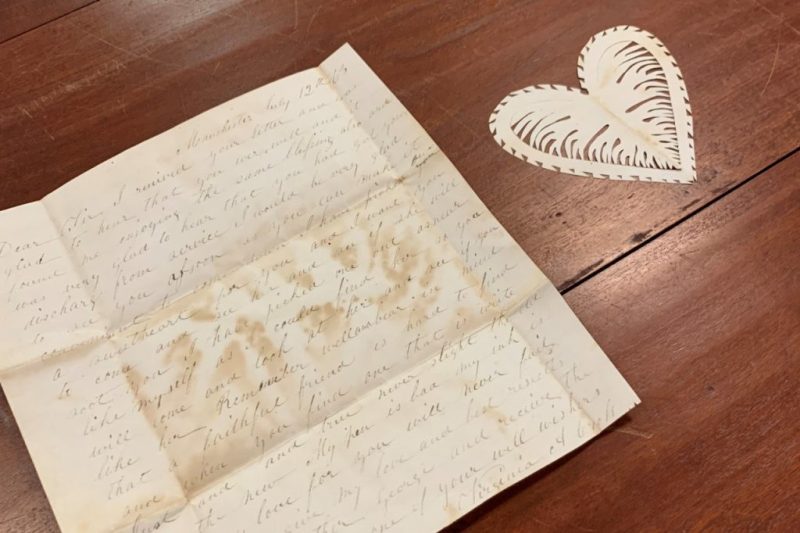
On July 12, 1863, a young Virginia Cross picked up a pen and ink, several sheets of precious paper, and wrote to her sweetheart, a discharged Civil War soldier. She used a small blade to cut an intricate and delicate white heart to enclose with her words.
“Dear Sir, I received your letter and was glad to hear that you were well and it found me enjoying the same feeling also and was very glad to hear that you had got your discharge from service,” writes Cross. “I would be very glad to see you as soon as you can make it convenient to come down.”
The letter continued with coyness and humor as Cross described a sweetheart she picked out for him. “I want you to come and see her and see if she will soot you,” wrote Cross. “I have picked one out as near like myself as I could find her so you will come and look at her and see if you like her.”
She then ended the letter with words of love, “Remember well and bear in mind that a faithful friend is hard to find and when you find one that is write just and true never slight the old for the new. My pen is bad my ink is pale my love for you will never fail.”
More than 150 years after Cross put pen to paper, Kira Dietz, Virginia Tech University Libraries assistant director of Special Collections and University Archives, said the flowing cursive handwriting, lack of punctuation and irregular spelling are common for letters of that time. The enclosed romance-inspired artwork, called Scherenschnitte or “scissor cuts,” is not.
“We purchased the letter from a Pennsylvania bookseller and gallery owner,” said Dietz. “This is a classic letter for scholars interested in the homefront, relationships and history of language during the Civil War. What makes this letter unique is the enclosed folk art. She folded the heart in half and used the blade to carve out the pattern so the design can be consistent.”
Special Collections and University Archives has one other letter carved in this way, but the carving was done inside the letter with the Civil War soldier author writing around the cuts. The Virginia Cross heart was an enclosure. Researchers can infer special meaning for using a separate piece of paper to make this gift.
“In 1863, during wartime, people were conservative about paper use,” said Deitz. “She used this extra piece of paper to create the art and it survived, still in one piece. It’s a heart detached at the bottom, it’s intricate work.”
Was her family well-to-do and able to afford the extra expense or was her love that strong for her sweetheart? We may never know.
“We don’t know if she wrote to a Union or Confederate soldier,” said Dietz. “The header says Manchester, but there are Manchesters in the North and South.”
Dietz has looked for Virginia Cross in the 1860 census and in marriage records around that time. She said finding anything about unmarried women can be tricky.
“It would be interesting to find out if she married the soldier,” added Dietz. “There aren’t a lot of details about Virginia or her beau.”
But who doesn’t love a 150-year-old romantic mystery?
“Our job is to create access to precious primary sources, like this love letter, for research,” said Dietz. “If we uncover a mystery along the way, that makes our job even more fun.”

